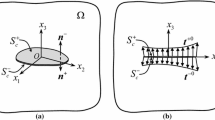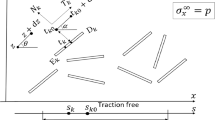Abstract
This paper deals with interactions in a two-dimensional cracked and porous medium. Interactions are computed using a semi analytical method based on ‘pseudo tractions’, in order to quantify the global behaviour of cracked materials. The number of singularities induced by cracks shows that the analytical pseudo tractions based on linear elastic fracture mechanics can be used to solve problems involving interactions. It is explained how the original technique of computation of interactions between cracks can be extended to finite media containing both circular cavities and cracks, with a Coulomb model for friction in cracks. The ability of the method to give accurate results is illustrated with some examples. The effects of interactions and presence of boundaries, introduced at a mesoscale, are illustrated here by some examples considering the global stiffness of the cracked media under tensile loading. The necessity of the computation of the interactions is related to the density of the cracks. Some simple expressions a vailable in the cases of weak interactions, and allowing friction in cracks, are developed. The pseudo tractions results are compared to those given by self consistent and differential techniques. Results involving porosity and crack closure with friction were shown in a previous paper [7].
Similar content being viewed by others
References
L. Gambarotta and S. Lagomarsino, International Journal of Solids and Structures 30 (1993) 177–198.
H.P. Yin, PhD thesis, Ecole Nationale des Ponts et Chaussées, France (1992).
A. Chudnovsky, A. Dolgopolsky and M. Kachanov, International Journal of Solids and Structures 23 (1987) 1–10.
Y. Benveniste, G.J. Dvorak, J. Zarzour and E.C. Wung, On interacting cracks and comples configurations in linear elastic media, Department of Civil Engineering, Rensselaer Institute, Troy, NY 12180, USA (1988).
M. Kachanov, Advances in Applied Mechanics 30 (1993) 229–445.
S. Ramtani, Y. Berthaud and J. Mazars, Nuclear Engineering and Design 133 (1992) 97–111.
C. Fond, J.L. Fléjou and Y. Berthaud, European Journal of Mechanics A/Solids 14 (1995).
M. Kachanov, International Journal of Fracture 28 (1985) R11-R19.
M. Kachanov, International Journal of Solids and Structures 1 (1987) 23–43.
E. Montagut and M. Kachanov, International Journal of Fracture 37 (1988) R55-R62.
N.I. Muskhelishvili, Some Basics Problem of the Mathematical Theory of Elasticity, Noordhoff, Groningen (1953).
J.W. Ju and K.H. Tseng, ASME 34 (1992) 69–82.
J.N. Goodier, ASME Transactions 55 (1933) 39–44.
L.G. Ting and Z.R. Zhong, Engineering Fracture Mechanics 35 (1990) 67–78.
Y. Berthaud, C. Fond and P. Brun, Mechanics Research Communications 21 (1994) 525–533.
C. Fond, PhD thesis, Université de Paris 6, France (1992).
J.P. Henry and F. Parsy, Cours d'élasticité, Dunod Université (1982).
S.P. Timoshenko and J.N. Goodier, Theory of Elasticity, McGraw-Hill (1951).
H. Horii and S. Nemat-Nasser, International Journal of Solids and Structures 21 (1985) 731–745.
Y. Belkacemi, Méthode des discontinuités de déplacement en champ complexe, Thèse de Doctorat de l'Université de Lille Flandres Artois (1990).
A. Bouhaddane, Application de l'intégrale de Cauchy à la méthode des discontinuités de déplacement et autres méthodes de collocation, Thèse de Doctorat de l'Université de Lille Flandres Artois (1987).
Y. Murakami, Stress Intensity Factors Handbook, Pergamon Press (1988).
C.A. Brebbia, J.C.F. Telles and L.C. Wrobel, Boundary Element Technique—Theory and Applications in Engineering, Springer-Verlag (1984).
R.E. Peterson, Stress Concentration Factors, John Wiley & Sons (1974).
J.D. Eshelby, Proceedings of the Royal Society of London/A 241 (1957) 376–396.
J. Mazars, Y. Berthaud and S. Ramtani, Engineering Fracture Mechanics 35 (1990) 629–635.
M. Kachanov and J.P. Laures, International Journal of Fracture 41 (1989) 289–313.
N. Laws and J.R. Brockenborough, International Journal of Solids and Structures 23 (1992) 56.
P. Brun, Private communication (1993).
B. Budiansky and R. O'Conell, International Journal of Solids and structures 12 (1976) 81–97.
M. S. Wu, Engineering Fracture Mechanics 48 (1994) 177–198.
Author information
Authors and Affiliations
Rights and permissions
About this article
Cite this article
Fond, C., Berthaud, Y. Extensions of the pseudo tractions technique for friction in cracks, circular cavities and external boundaries; effect of the interactions on the homogenised stiffness. Int J Fract 74, 1–28 (1996). https://doi.org/10.1007/BF00018572
Received:
Accepted:
Published:
Issue Date:
DOI: https://doi.org/10.1007/BF00018572




